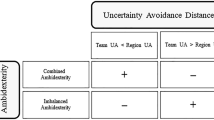Abstract
Literature has shown that IT ambidexterity can significantly enhance organizational agility or performance. However, little attention has been paid to how to foster IT ambidexterity. Through the lens of CIO-TMT knowledge interaction, this paper empirically examines the effects two different types of CIO-TMT knowledge interaction mechanisms (i.e., structural and social systems of knowing) on IT ambidexterity and the moderating effects of environmental dynamism. Data analysis and model estimation are performed on matched-pair survey of 347 Chinese shipbuilding firms by applying structural equation model. Results show that both structural and social systems of knowing positively affect IT ambidexterity and serve as substitutes. Environmental dynamism positively moderates the relationship between social systems of knowing and IT ambidexterity, but has no moderating impact on the structural systems of knowing and IT ambidexterity. Moreover, the three-way interaction among environmental dynamism, structural and social systems of knowing also suggests that the substitution effect between structural and social systems of knowing will be weakened in dynamic environments. This study extends the IT ambidexterity literature by examining its antecedents through the lens of knowledge interaction between CIO and TMT, which makes a significant contribution to both IS research and practice.
Access this chapter
Tax calculation will be finalised at checkout
Purchases are for personal use only
Similar content being viewed by others
References
Lee, O.-K., Sambamurthy, V., Lim, K.H., et al.: How does it ambidexterity impact organizational agility? Inf. Syst. Res. 26(2), 398–417 (2015)
Daft, R.L., Lengel, R.H.: Organizational information requirements, media richness and structural design. Manag. Sci. 32(5), 554–571 (1986)
Heavey, C., Simsek, Z.: Distributed cognition in top management teams and organizational ambidexterity: the influence of transactive memory systems. J. Manag. 43(3), 919–945 (2017)
Gibson, C.B., Birkinshaw, J.: The antecedents, consequences, and mediating role of organizational ambidexterity. Acad. Manag. J. 47(2), 209–226 (2004)
Raisch, S., Birkinshaw, J., Probst, G., et al.: Organizational ambidexterity: balancing exploitation and exploration for sustained performance. Organ. Sci. 20(4), 685–695 (2009)
Liang, H., Wang, N., Xue, Y.: Juggling information technology (it) exploration and exploitation: a proportional balance view of it ambidexterity. Inf. Syst. Res. 33(4), 1386–1402 (2022)
Syed, T.A., Blome, C., Papadopoulos, T.: Impact of it ambidexterity on new product development speed: theory and empirical evidence. Decis. Sci. 51(3), 655–690 (2020)
Mithas, S., Rust, R.T.: How information technology strategy and investments influence firm performance: conjecture and empirical evidence1. MIS Q. 40(1), 223–246 (2016)
Steelman, Z.R., Havakhor, T., Sabherwal, R., et al.: Performance consequences of information technology investments: implications of emphasizing new or current information technologies. Inf. Syst. Res. 30(1), 204–218 (2019)
Zheng, J., Liu, H., Zhou, J.: High-performance work systems and open innovation: moderating role of it capability. Ind. Manage. Data Syst. 120(8), 1441–1457 (2020)
Guinea, A.O.D., Raymond, L.: Enabling innovation in the face of uncertainty through it ambidexterity: a fuzzy set qualitative comparative analysis of industrial service SMEs. Int. J. Inf. Manage. 50, 244–260 (2020)
Galbraith, J.R.: Organization design: an information processing view. Interfaces 4(3), 28–36 (1974)
Armstrong, C.P., Sambamurthy, V.: Information technology assimilation in firms: the influence of senior leadership and it infrastructures. Inf. Syst. Res. 10(4), 304–327 (1999)
Preston, D.S., Karahanna, E.: Antecedents of is strategic alignment: a nomological network. Inf. Syst. Res. 20(2), 159–179 (2009)
Xue, L., Ray, G., Sambamurthy, V.: Efficiency or innovation: how do industry environments moderate the effects of firms’ it asset portfolios?. MIS Quart. 36, 509–528 (2012)
Jansen, J.J.P., Van Den Bosch, F.A.J., Volberda, H.W.: Exploratory innovation, exploitative innovation, and performance: effects of organizational antecedents and environmental moderators. Manag. Sci. 52(11), 1661–1674 (2006)
Jansen, J.J.P., Tempelaar, M.P., Bosch, F.A.J.V.D., et al.: Structural differentiation and ambidexterity: the mediating role of integration mechanisms. Organ. Science 20(4), 797–811 (2009)
Wang, H., Li, J.: Untangling the effects of overexploration and overexploitation on organizational performance: the moderating role of environmental dynamism. J. Manag. 34(5), 925–951 (2008)
Wang, N., Liang, H., Zhong, W., et al.: Resource structuring or capability building? An empirical study of the business value of information technology. J. Manag. Inf. Syst. 29(2), 325–367 (2012)
Podsakoff, P.M., MacKenzie, S.B., Lee, J.-Y., et al.: Common method biases in behavioral research: a critical review of the literature and recommended remedies. J. Appl. Psychol. 88(5), 879 (2003)
Acknowledgement
This research was supported by the National Natural Science Foundation of China under Grant 71971101.
Author information
Authors and Affiliations
Corresponding author
Editor information
Editors and Affiliations
Rights and permissions
Copyright information
© 2023 The Author(s), under exclusive license to Springer Nature Switzerland AG
About this paper
Cite this paper
Zhang, Y., Wang, N., Hu, H. (2023). Developing IT Ambidexterity: Insights from Knowledge Interaction Between CIO and TMT. In: Tu, Y., Chi, M. (eds) E-Business. Digital Empowerment for an Intelligent Future. WHICEB 2023. Lecture Notes in Business Information Processing, vol 481. Springer, Cham. https://doi.org/10.1007/978-3-031-32302-7_8
Download citation
DOI: https://doi.org/10.1007/978-3-031-32302-7_8
Published:
Publisher Name: Springer, Cham
Print ISBN: 978-3-031-32301-0
Online ISBN: 978-3-031-32302-7
eBook Packages: Computer ScienceComputer Science (R0)




